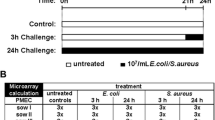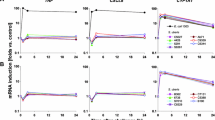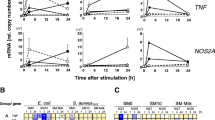Abstract
An in vitro co-culture model of SCp2 mammary epithelial cells and Escherichia coli strains was established in bacterial non-CO2 incubators. Co-culturing SCp2 cells with either the rod-shaped W3110 or spherical-shaped GC7378Tn10 strains of Escherichia coli led to an increase in interleukin-6 (IL-6) levels by SCp2 cells after 9 h. At a ratio of 1:100 (epithelial:bacterial), the rod-shaped W3110 strain induced almost double the amount of IL-6 induced by the spherical-shaped GC7378Tn10 strain. The effect of Escherichia coli morphology (rod versus spherical) on IL-6 production by SCp2 cells was further investigated by shifting GC7378Tn10 morphology to rod through introducing the pbpA gene by transduction and transformation. In both approaches, the generated rod strains elicited higher IL-6 levels in SCp2 cells compared to the spherical ones at 1:50 and 1:100 ratios (epithelial:bacterial). Our findings demonstrate the significance of cell shape in bacterial–host interactions with potential implications in bacterial pathogenesis in general.




Similar content being viewed by others
Literature Cited
Akira S, Hemmi H (2003) Recognition of pathogen-associated molecular patterns by TLR family. Immunol Lett 85:85–95
Almeida RA, Oliver SP (2001) Interaction of coagulase-negative Staphylococcus species with bovine mammary epithelial cells. Microb Pathog 31:205–212
Dopfer D, Almeida RA, Lam TJ, Nederbragt H, Oliver SP, Gaastra W (2000) Adhesion and invasion of Escherichia coli from single and recurrent clinical cases of bovine mastitis in vitro. Vet Microbiol 74:331–343
El-Sabban ME, Abi-Mosleh LF, Talhouk RS (2003) Developmental regulation of gap junctions and their role in mammary epithelial cell differentiation. J Mammary Gland Biol Neoplasia 8:463–473
Hosoi T, Hirose R, Saegusa S, Ametani A, Kiuchi K, Kaminogawa S (2003) Cytokine responses of human intestinal epithelial-like Caco-2 cells to the nonpathogenic bacterium Bacillus subtilis (natto). Int J Food Microbiol 82:255–264
Lu L, Walker WA (2001) Pathologic and physiologic interactions of bacteria with the gastrointestinal epithelium. Am J Clin Nutr 73:1124S–1130S
Matsuzawa H, Asoh S, Kunai K, Muraiso K, Takasuga A, Ohta T (1989) Nucleotide sequence of the rodA gene responsible for the rod shape of Escherichia coli: rodA and the pbpA gene, encoding penicillin-binding protein 2, constitute the rodA operon. J Bacteriol 171:558–560
Matthews KR, Murdough PA, Bramley AJ (1997) Invasion of bovine epithelial cells by verocytotoxin-producing Escherichia coli O157:H7. J Appl Microbiol 82:197–203
Miles AA, Misra SS (1938) The estimation of the bactericidal power of the blood. J Hygiene 38:732–749
Milner JS, Dymock D, Cooper RM, Roberts IS (1993) Penicillin-binding proteins from Erwinia amylovora: mutants lacking PBP2 are avirulent. J Bacteriol 175:6082–6088
Ogura T, Bouloc P, Niki H, D’Ari R, Hiraga S, Jaffe A (1989) Penicillin-binding protein 2 is essential in wild-type Escherichia coli but not in lov or cya mutants. J Bacteriol 171:3025–3030
Reed KA, Hobert ME, Kolenda CE, Sands KA, Rathman M, O’Connor M, Lyons S, Gewirtz AT, Sansonetti PJ, Madara JL (2002) The Salmonella typhimurium flagellar basal body protein FliE is required for flagellin production and to induce a proinflammatory response in epithelial cells. J Biol Chem 277:13346–13353
Roe IH, Son SH, Oh HT, Choi J, Shin JH, Lee JH, Hah YC (1999) Changes in the evolution of the antigenic profiles and morphology during coccoid conversion of Helicobacter pylori. Korean J Intern Med 14:9–14
Safieh-Garabedian B, Mouneimne GM, El-Jouni W, Khattar M, Talhouk R (2004) The effect of endotoxin on functional parameters of mammary CID-9 cells. Reproduction 127:397–406
Sambrook J, Fritsch EF, Maniatis T (1989) Molecular cloning; a laboratory manual, 2nd ed. Cold Spring Harbor: Cold Spring Harbor Laboratory Press
Sansonetti P (2002) Host-pathogen interactions: the seduction of molecular cross talk. Gut 50(Suppl 3):III2–III8
Spratt BG (1975) Distinct penicillin binding proteins involved in the division, elongation and shape of Escherichia coli K-12. Proc Natl Acad Sci USA 72:2999–3003
Svanborg C, Agace W, Hedges S, Linder H, Svensson M (1993) Bacterial adherence and epithelial cell cytokine production. Zentralbl Bakteriol 278:359–364
Tamaki S, Matsuzawa H, Matsuhashi M (1980) Cluster of mrdA and mrdB genes responsible for the rod shape and mecillinam sensitivity of Escherichia coli. J Bacteriol 141:52–57
Walters K, Maroofi A, Hitchin E, Mansfield J (1990) Gene for pathogenicity and ability to cause the hypersensitive reaction cloned from Erwinia amylovora. Physiol Mol Plant Pathol 36:509–521
Acknowledgments
This work was supported by grants from University Research Board (URB, American University of Beirut (AUB), Lebanon), Lebanese National Council for Scientific Research (LNCSR, Lebanon), and HITECH-FZE made to IBSAR (Initiative for Biodiversity Studies in Arid Regions, AUB, Lebanon).
Author information
Authors and Affiliations
Corresponding authors
Rights and permissions
About this article
Cite this article
Khattar, M.M., Bazzi, S., Kogan, J. et al. Bacterial Cell Shape–Dependent Inflammatory Response in Mammary Epithelial Cells. Curr Microbiol 52, 424–429 (2006). https://doi.org/10.1007/s00284-005-0100-4
Received:
Accepted:
Published:
Issue Date:
DOI: https://doi.org/10.1007/s00284-005-0100-4




